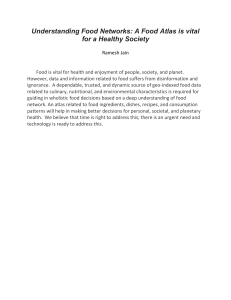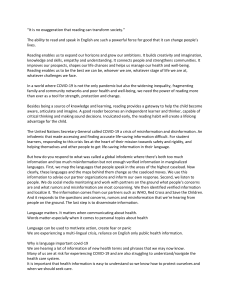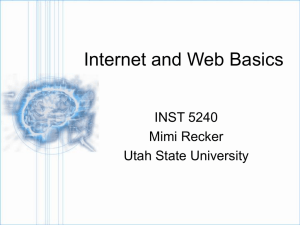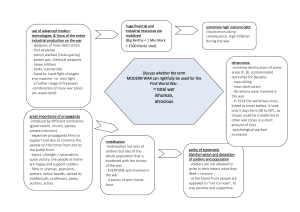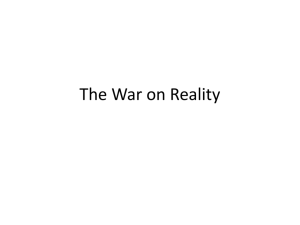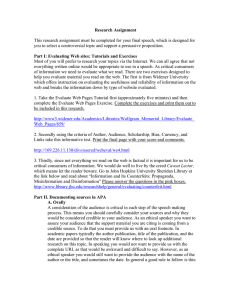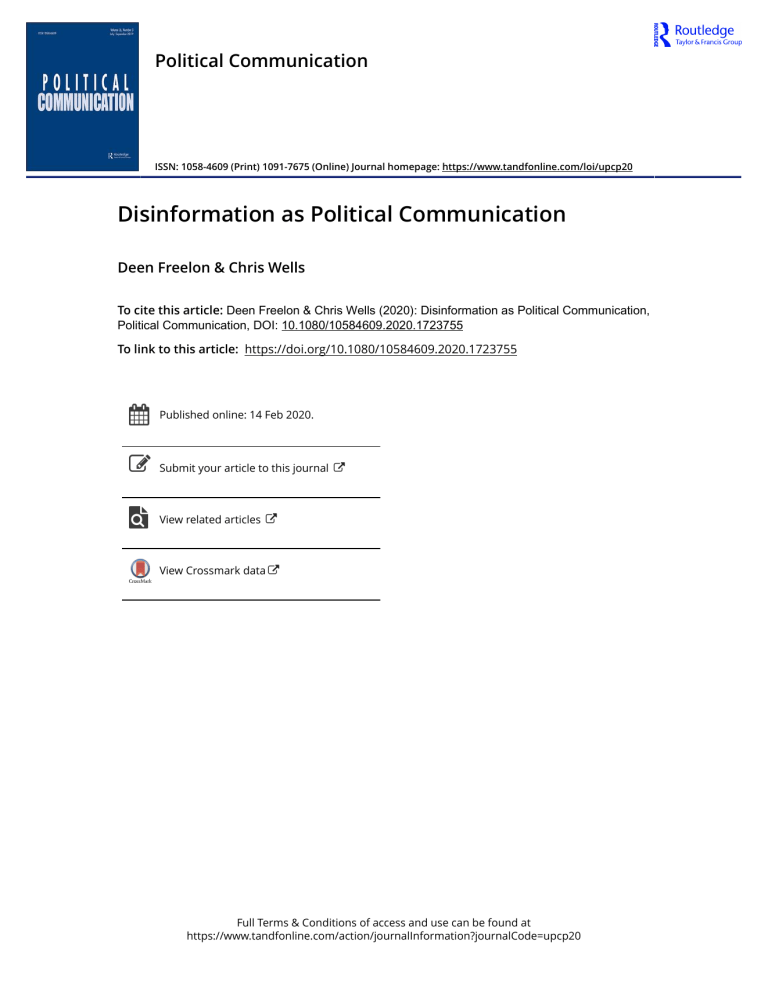
Political Communication ISSN: 1058-4609 (Print) 1091-7675 (Online) Journal homepage: https://www.tandfonline.com/loi/upcp20 Disinformation as Political Communication Deen Freelon & Chris Wells To cite this article: Deen Freelon & Chris Wells (2020): Disinformation as Political Communication, Political Communication, DOI: 10.1080/10584609.2020.1723755 To link to this article: https://doi.org/10.1080/10584609.2020.1723755 Published online: 14 Feb 2020. Submit your article to this journal View related articles View Crossmark data Full Terms & Conditions of access and use can be found at https://www.tandfonline.com/action/journalInformation?journalCode=upcp20 POLITICAL COMMUNICATION https://doi.org/10.1080/10584609.2020.1723755 Disinformation as Political Communication Deen Freelona and Chris Wellsb a Hussman School of Journalism and Media, University of North Carolina at Chapel Hill, Chapel Hill, North Carolina, USA; bDepartment of Journalism, Boston University, Boston, Massachusetts, USA ABSTRACT This introduction to the special issue “Beyond Fake News: The Politics of Disinformation” contains four main sections. In the first, we discuss the major sociopolitical factors that have allowed disinformation to flourish in recent years. Second, we review the very short history of disinformation research, devoting particular attention to two of its more extensively studied conceptual relatives: propaganda and misinformation. Third, we preview the seven articles in this issue, which we divide into two types: studies of disinformation content and of disinformation reception. We conclude by advancing a few suggestions for future disinformation research. KEYWORDS disinformation; propaganda; fake news; misinformation; problematic information Our field and media consumers worldwide have in recent years become fascinated and dismayed by a constellation of media genres that includes “fake news,” “misinformation,” “disinformation,” “media manipulation,” “coordinated inauthentic behavior,” and “propaganda.” Indeed, we argue that this constellation is the defining political communication topic of our time, given the massive media attention, reams of scholarship, and unprecedented funding opportunities devoted to it. Of course, none of this content is entirely new, but it is newly salient, and the digital age has changed how such messages are created, circulated, and interpreted, as well as their potential effects. The fear that messages of dubious provenance and truth value may subvert the “proper” functioning of democracy (however that is understood) has motivated governments, citizens, and scholars to try to understand and combat the phenomenon. This special issue contributes to a better scholarly understanding of disinformation, which is one distinct species of what some have called “problematic information” (Giglietto, Iannelli, Valeriani, & Rossi, 2019; Jack, 2017; Molina, Sundar, Le, & Lee, 2019). As disinformation and its conceptual siblings are often conflated in popular conversations, and sometimes in scholarly ones, we feel it is important to start with a definition. We see no need to compose our own, as the High Level Expert Group on Fake News and Online Disinformation of the European Commission wrote a succinct and useful one in 2018: “Disinformation … includes all forms of false, inaccurate, or misleading information designed, presented and promoted to intentionally cause public harm or for profit” (Disinformation, 2018, p. 3). This definition unites three critical criteria: 1) deception, 2) potential for harm, and 3) an intent to harm. It thus excludes deceptive messages that may cause harm without the disseminators’ knowledge (misinformation) and non-deceptive messages intended to harm others (e.g. slurs based on racial, sexual, or CONTACT Deen Freelon freelon@email.unc.edu Carolina at Chapel Hill, Chapel Hill, NC 27515, USA. © 2020 Taylor & Francis Group, LLC Hussman School of Journalism and Media, University of North 2 D. FREELON AND C. WELLS gender identity). Disinformation messages under this definition are munitions in campaigns of information warfare, non-lethal weapons intended to subdue adversaries rather than reason with them. Given the threat disinformation poses to healthy democratic practice, this special issue’s authors all adopt a normative stance against it, as do we. This introductory essay is organized into four sections following this one. We begin by situating our understanding of disinformation within the wider crisis of democracy and political communication. Second, we briefly review the history of the study of problematic information in communication, paying particular attention to the massive increase in research activity since 2016. Next, we highlight key findings and points of agreement within this issue’s articles, which we divide into two broad categories: content studies and reception studies. We conclude by discussing several critical research questions about disinformation that have yet to be thoroughly explored. But before proceeding, we would like to make a brief point regarding the term “fake news.” It has been widely used in popular conversations about problematic information, most prominently by Donald Trump, as well as in scholarly research (e.g. by Bronstein, Pennycook, Bear, Rand, & Cannon, 2019; Khaldarova & Pantti, 2016; Vargo, Guo, & Amazeen, 2018). With respect to our colleagues, we advocate against uses of this term to refer to concepts of theoretical relevance. We argue that its use by Trump and his followers to delegitimize unfavorable news coverage has stripped it of any analytical value it may have once held. Even beyond that tendentious usage, ambiguity around its many other referents (which include comedic and satirical news content such as the Daily Show and the Onion) suggest that researchers should apply more precise language to their objects of study. Hence, this special issue represents an attempt to advance “beyond fake news” in scholarship of problematic information by focusing on one specific subtype thereof: disinformation. Context We are wary of attempting to conceptualize the contemporary nature of digital disinformation without placing that disinformation in a wider context. The environment in which contemporary, largely digital, disinformation has arisen and operates is one of a larger “crisis of public communication”; a “disinformation order” that has been developing for much longer than the current breed of digital disinformation. More comprehensive treatments of this thesis can be found elsewhere (e.g. Bennett & Livingston, 2018; Chadwick, 2019; Wardle & Derakhshan, 2017); but we do feel it necessary to ground ourselves by recognizing critical elements of the social, political, and economic context that underlie the forms of disinformation that are the focus of this issue. The widespread and growing distrust among Western publics in institutions of the press is an inescapable reality: in the United States, overall confidence that news media report the news “fully, accurately and fairly” has fallen steadily since the 1970s, reaching an all-time low in 2016 prior to the presidential election, after which the measure has sharply polarized (Gallup, 2019). The decline in trust in the press is both concomitant with declines in public faith in other institutions of democratic governance and a phenomenon in its own right. There is a profound sense among large portions of Western democratic societies that contemporary governance structures, and the information systems assigned to hold them accountable, are not working (Achen & Bartels, 2016; Foa & Mounk, 2016; Ladd, 2011). The deep political contentiousness and polarization of (especially the more engaged portions of) publics must also be recognized here as it has a direct bearing on both falling POLITICAL COMMUNICATION 3 trust in the press and engagement in disinformation sharing and consumption. Fiercely negative affect now characterizes many partisans’ attitudes toward members of the opposite party (Iyengar & Westwood, 2015), and this antipathy corresponds to online information sharing (Conover et al., 2011). Social media networks play a special role here, as users encountering news through social media appear to place as much weight on the social identity of the sharer as the reputation of the creator in determining informational credibility, further undermining the potentially moderating role of centrist journalistic media (Messing & Westwood, 2012). We would be remiss not to note corresponding developments in the political economy of political media, which in many ways aggravate these dynamics. Scholars such as Berry and Sobieraj (2014) and Peck (2019) have detailed the lucrative partisan media spaces carved out first on radio in the wake of the Fairness Doctrine repeal, and then with the expansion of media choice via cable television and the Internet. These business models demonstrate both the viability of niche-market targeting, and the political-cultural styles that can attract dedicated audiences more for the delivery of identity solidarity than informed discourse (Kreiss, 2018; Peck, 2019).1 The current state of digital disinformation, whose practices frequently trade on the same appeals, is deeply rooted in these developments. The underlying economics of the press under conditions of digital advertising and heavy platformization (Nieborg & Poell, 2018) compound the challenges of the business of the journalism of verification, undermining our society’s main defense against disinformation (Pickard, 2019). Increasingly dependent on monetizing the now all-too-measurable attention of individuals clicking through social media links on laptops and smartphones, news organizations now compete for viewers with all manner of enticing content, political and otherwise, much of which feels no obligation to any degree of factual reliability. Munger (2019) describes this as a “Clickbait Media” economic arrangement in which legacy news organizations compete with low-cost, zero-credibility upstarts who can often attract large numbers of viewers. And the competition is fierce: Bradshaw and colleagues show in this issue that “junk news” reached parity with professional news sources when it came to generating shares on Twitter during the 2016 presidential election. Unfortunately, some of the responses of news organizations to this situation appear themselves to be harmful to press credibility. Clickbait is a daily experience of news consumers, reliably found if one scrolls down far enough on most news websites. The rise of native advertising also appears to be doing press credibility few favors. Presented with widely varying degrees of transparency, native advertising is clearly attractive for the advertising dollars it can provide. And in an important sense, it “works”: fewer than 10% of consumers recognize it as paid advertising (Amazeen, 2019). But the medium-to-long term consequences must not be overlooked. Being made aware of the true nature of native content drives down perceptions of the credibility of the news producer (Amazeen & Muddiman, 2018). In short, contemporary online news consumers are awash in dubious, manipulative content—even on the webpages of some of the world’s highest-quality news sites. There is a final way in which journalistic media intersect with disinformation in this complicated landscape: news organizations’ awareness of the need to disperse content through social media networks has led them to rely increasingly heavily on measures of where the public’s attention is trending, to the frustration of many journalists (McGregor, 2019; Tandoc, 2014), and to integrate themselves into many social media platforms. Without very careful attention to the investigation and verification of the origins of 4 D. FREELON AND C. WELLS individual statements and trends emanating from social media, respected news media can themselves be used by disinformation campaigns “trading up the chain” (Marwick & Lewis, 2017), an example of which Krafft and Donovan illustrate in this issue (see also Lukito et al., 2019). Our intention with these points is not to criticize the work of journalists or news organizations that defend the public daily against a genuinely post-truth reality; indeed, many are engaged in remarkable work to navigate this treacherous terrain (Graves, 2016). But in introducing the concept of disinformation, we do hope to take a clear-eyed view of the political, communication, and economic environment from which modern concerns about disinformation have, quite suddenly, emerged. From Propaganda to Disinformation Disinformation as currently defined appears not to have been a major research priority in the social sciences prior to 2017. The Anglicization of the Russian term dezinformatsiya dates back to at least 1955 (“Disinformation, n.,” n.d.), but since then, only a small collection of isolated historical analyses and case studies spread across several disciplines has directly addressed the topic in scholarly contexts (including Boghardt, 2009; Clogg, 1997; Fetzer, 2004; Kux, 1985; Martin, 1982; Romerstein, 2001). These publications do not constitute a “literature” in the usual sense, as they generally do not reference each other or seek to build a broad program of empirical disinformation research. As such, their relevance to contemporary disinformation research is modest at most. In contrast, the study of propaganda has a long history in communication research. Its origins can be traced to the Institute for Propaganda Analysis (IPA), an organization that operated between 1937 and 1942 to help the public understand and critically analyze what its members called the “distortion of public opinion” (Lee & Lee, 1939, p. viii). The IPA is perhaps best known for its list of seven widely used propaganda tropes, or “devices,” that offered scholars and the public tools for designating media messages as propaganda (see Sproule, 2001, for a history of these devices). After the IPA’s dissolution, the study of propaganda in the field of communication became a largely qualitative affair. A handful of articles published in this very journal throughout the 1980s and 1990s analyze propaganda using primarily rhetorical and historical methods (Harmon, 1992; Kampf, 1987; Kieh, 1990; Martin, 1982; Parry-Giles, 1994; Symms & Snow, 1981). Book-length treatments of the topic applied similar approaches (Sproule, 1997; Taylor, 2003). While some of this work aligned directly with the anticommunist Western foreign policy consensus of the Cold War (Harmon, 1992; Kampf, 1987; Martin, 1982; Symms & Snow, 1981), others took aim at American propaganda directed at foreign targets (Kieh, 1990; Parry-Giles, 1994). This latter tradition was most evident in research based on Herman and Chomsky’s propaganda model (2011), which situated the American news media as the most prominent disseminators of elite ideologies. Such studies are, like their foundational work, steeped in critical theory that traces power through media channels that reject charges of servility to government and corporate interests (e.g. Altheide & Grimes, 2005; Jackson & Stanfield, 2004; Jang, 2013; Kennis, 2009). The general thrust of these analyses thus differs fundamentally from that of the current articles, which focus on media messages produced with manifestly duplicitous intent. Before the influx of popular and academic interest in disinformation in 2016, the still-nascent field’s closest conceptual relative was the study of misinformation. This concept is somewhat POLITICAL COMMUNICATION 5 easier to study than disinformation because it does not require a finding of malicious intent: messages need only be false and potentially harmful to qualify as such. The concept was first developed by cognitive psychologists interested in its effects on memory formation (Loftus & Hoffman, 1989), visual object classification (Pishkin, 1960), children’s ability to infer the mental states of others (Perner & Wimmer, 1988), and performance on multiple-choice tests (Frary, 1980). Political and communication researchers mentioned the phenomenon in passing throughout the 1970s and 1980s, with only a few papers examining it directly (including ArcusTing, Tessler, & Wright, 1977; Johnson & Nimmo, 1986; Powell, 1989). This trend continued into the 1990s as part of political science’s embrace of psychology’s cognitive revolution (Hofstetter, Barker, Smith, Zari, & Ingrassia, 1999; Kuklinski, Quirk, Schwieder, & Rich, 1998; Leitenberg, 1999; Price & Hsu, 1992), though more popular cognitively oriented topics such as political sophistication and how voters make decisions far outpaced it. Still, this early work in political misinformation drew at least two substantial conclusions from which present-day research still draws: 1) that the cognitive domain is an important, if not the most important, locus of misinformation studies; and 2) that mere ignorance or incorrect guesses do not qualify as misinformation, which instead requires a strong degree of confidence in the truth of a factually false belief (Kuklinski et al., 1998). In the 21st century, interest in the topic increased greatly, driven by factors such as the contemporaneous popularity of participatory media and rising distrust in scientific and medical authority (e.g. Bessi et al., 2015; Cogley, Kargel, Kaser, & van der Veen, 2010; Del Vicario et al., 2016). Prior to 2017, disinformation was rarely a topic of primary analysis—when the term did appear, it was usually as a minor detail in a discussion of another object of study. But the 2016 election and its aftermath prompted a rush of interest on the topic from a wide range of disciplines including communication, political science, and information science. As a very rough indicator of scholarly interest, we note 238 Google Scholar results from 2000 to 2009 whose titles contain the term (including unrelated uses from finance and medicine).2 Between 2010 and 2016, that number is 257, but between 2017 and 2019, it ballooned very quickly to 609. Thus, between 2010 and 2019, over 70% of the Google Scholar results containing “disinformation” in their titles were published after 2016. This strikes us as clear evidence of a surge in scholarly interest. As limitations of space and focus prevent us from comprehensively reviewing the relevant literature, here we will acknowledge a few of the most foundational early works in disinformation research. Two prominent white papers (Faris et al., 2017; Marwick & Lewis, 2017), each published in August 2017, provided detailed case studies of US-focused disinformation practices upon which the articles in this issue rely heavily. Allcott and Gentzkow (2017) published the first large-scale analysis of the spread of so-called “fake news” (which by our definition is a type of disinformation) and found, among other things, that such stories were unlikely to have swayed the election. Finally, two state-of-the-art reviews of research on “fake news” (Lazer et al., 2018) and political polarization and disinformation (Tucker et al., 2018) appeared in March 2018, laying the groundwork for studies to come. Disinformation: Content and Reception As we demonstrate above, the articles in this special issue belong to a literature still in its infancy. Theoretical approaches are still fairly scattered; we have not yet reached the point of being able to divide studies according to competing intellectual traditions or expected types of effects. 6 D. FREELON AND C. WELLS Instead, we classify the current studies into two broad categories: content and reception. As the name implies, content studies analyze disinformation content and in so doing attempt to draw conclusions about its intended purposes, audiences, and effects. Reception studies are generally survey and/or experiment-based and seek to determine how exposure to disinformation affects opinions, attitudes, and behaviors. We begin by previewing the content cluster, which contains four studies; and continue with the reception studies, of which there are three. Content Studies Four studies focused on the supply side of disinformation illustrate the wide variety of actors shaping this part of our information system. Bradshaw and colleagues take the widest view, using a grounded approach to typologize the myriad of online sources now shared on social media during major political debates. These scholars take important steps to move our field beyond often-unproductive debates over the precise definition of fake news, instead arguing for attention to the concept of junk news, which they define in reference to five theoretically informed criteria. What their study makes clear is that American social media during the 2016 presidential election was awash in junk news: they find that it was shared as often as news from respected professional news sources. More professional news appeared to take the upper hand in the 2018 State of the Union address, but future research will be needed to know if this was a result of correction on the part of social media users or platforms, lessened attention to the State of the Union by purveyors of junk news, a different audience of social media users tuning in to that event, or something else. By contrast, Krafft and Donovan go micro, offering a detailed investigation of the development of a false rumor as users of 4chan, 8chan, and other right-wing platforms explore and ultimately misidentify the perpetrator of a lethal automobile assault during 2017’s Unite the Right rally. Their study details the linkages between peer production practices in the corners of the Internet and better-known news websites, an illustration of “trading up the chain” dynamics in action. Both Keller and colleagues and Lukito home in on a particularly important sort of disinformation creator: state actors. Keller et al. helpfully move beyond the “bot or human” debate by analyzing a state-sponsored disinformation campaign in South Korea according to a more holistic principal-agent framework. They carefully articulate strategic rationales for human, automated, and hybrid modes of presenting disinformation in social media, and present data to both illustrate the behavior of known disinformation accounts and identify previously unreported likely disinformation accounts. Lukito takes as her subject the operations of Russia’s 2016 campaign during the U.S. Presidential Election. Hers is one of the first studies to date to quantitatively assess the construction of a disinformation campaign across multiple social media—Facebook, Twitter, and Reddit. Time series analyses indicate that Russian account operators may have themselves been engaged in “trial-ballooning,” a practice with parallels to trading up the chain, in that activities on Reddit may have been tested before rollout on Twitter. Reception Studies The three reception studies all ground themselves firmly in the political psychology tradition. Specifically, all draw on theories of motivated reasoning, confirmation bias, POLITICAL COMMUNICATION 7 and message-attitude consistency in predicting cognitive responses or behaviors. From this shared foundation, each study branches out to elucidate the specific effects of various psychological factors on the extent to which participants endorse, believe, or act based on demonstrably false claims: Zimmermann and Kohring focus on populist attitudes; Powell, Hameleers, van der Meer, and Bos consider differences between text-only and visual messages; and Garrett, Sude, and Riva investigate the role of ostracism. Similarities in findings are strongly evident between the latter two studies, both of which employed experiments to test the effects of fact-checking messages on participants’ willingness to believe partisan disinformation. Both studies’ results support the efficacy of fact-checking efforts under certain circumstances: Powell et al. find that fact-checks consistently reduce the credibility of disinformation across issues, with the effect being strongest among those who agreed with the general ideological thrust of the disinformation. Garrett et al. find that participants who were manipulated to feel ostracized in a simulated social media environment were more likely to persist in endorsing messages about attitude-congruent partisan falsehoods even in the face of evidence to the contrary. This effect was stronger among those without strong ideological affiliations and those who rely on intuition over analysis when processing information. Zimmermann and Kohring’s research diverges from these two studies by directly investigating potential disinformation effects on voting behavior using a panel survey. One key finding is that participants who exhibited low degrees of trust in the political system and media were most vulnerable to disinformation belief. Even more striking, former supporters of the governing CDU/CSU party who had viewed disinformation content were especially likely to transfer their support to far-right wing parties such as the AfD. Conclusion: The Future of Disinformation Research Unfortunately for democratic practice, disinformation will likely continue to be a fertile and important topic for future political communication research. The studies in this special issue raise as many questions as they answer. Moving forward, we see several critical unanswered questions and under-studied lines of inquiry, several of which we will highlight here. First, more research is needed in the area of disinformation effects. One of the major distinctions between disinformation and misinformation is that the former is specifically constructed to produce effects, ones which assault key assumptions undergirding collective political decisionmaking. Questions of what kinds of effects, their magnitude, and the circumstances under which they are most likely to manifest are vitally important to both political communication theory as well as the public at large. Therefore, we exhort the disinformation research community to follow Zimmermann and Kohring’s example in answering such questions across a range of political contexts and topics. Second, apart from behavioral effects, questions remain about differences in disinformation exposure and credibility among specific subpopulations. Existing research has found evidence of partisan asymmetry here—specifically that conservatives are disproportionately likely to be targeted by disinformation purveyors (Faris et al., 2017; Freelon & Lokot, 2020; Howard, Ganesh, Liotsiou, Kelly, & Francois, 2018) and believe or share disinformation content when exposed (Allcott & Gentzkow, 2017; Grinberg, Joseph, Friedland, Swire-Thompson, & Lazer, 2019; Guess, Nagler, & Tucker, 2019). But other asymmetries may also exist, for example along ethnoracial lines. The fact that state-sponsored disinformation agents such as the Internet 8 D. FREELON AND C. WELLS Research Agency targeted Black American social media users more than any other minority population (DiResta et al., 2018; Howard et al., 2018) is worth exploring further for that reason. Beyond that, the partisan asymmetry finding requires careful monitoring over time. Is it a persistent phenomenon rooted in stable psychological differences between liberals and conservatives, or a transient artifact elicited in large part by the current US administration? Between-country analyses will help to answer this question, as well as identify additional subpopulations at high risk of disinformation exposure and endorsement. A third area of inquiry focuses on the contested nature of the way scholars and the public conceptualize problematic information. Among other things, the term connotes the speaker’s normative objections to the messages in question (indeed, many Trump supporters likely would classify CNN and the New York Times as “problematic information”), which renders it overly broad and subjective, albeit superior to its alternatives. The extent to which the specific definitional criteria for disinformation outlined at the start of this essay matter in terms of exposure, effects, and other dependent variables of interest is still unknown. By the same token that the difference between a factual error and a lie can be tremendously relevant in legal contexts, so might we expect the distinction between misand disinformation to hold substantial implications for exposure, transmission, effects, and remedies. But these are empirical questions—it may turn out, for example, that the two phenomena’s empirical and statistical characteristics are similar enough that the same conceptual models and corrective techniques can be effectively applied to both. To ascertain which is the case, research must be carefully designed to compare the two along with other related but potentially distinct conceptual relatives. The 2020 US elections will no doubt afford great advances in the study of disinformation, as such messages grow in sophistication, subtlety, and efficacy. With Bennett and Livingston (2018), we recognize both the theoretical and practical importance of studying this new disinformation order, and expect the articles in this special issue to contribute substantially to this new and rapidly evolving field. Notes 1. In the American context, here we have in mind media properties such as Rush Limbaugh, Fox News, and Breitbart; it is a reality—surely not lost on MSNBC’s parent company—that this approach has been most successful on the political right (Benkler, Faris, & Roberts, 2018). 2. While this number may seem high, we note that many of these results are news articles, blog posts, unpublished opinion pieces, and other non-empirical publications. Disclosure statement No potential conflict of interest was reported by the authors. Notes on contributors Deen Freelon is an associate professor in the Hussman School of Journalism at the University of North Carolina at Chapel Hill. Chris Wells is an assistant professor in the Department of Journalism at Boston University. POLITICAL COMMUNICATION 9 References Achen, C. H., & Bartels, L. M. (2016). Democracy for realists: Why elections do not produce responsive government. Princeton, NJ: Princeton University Press. Allcott, H., & Gentzkow, M. (2017). Social media and fake news in the 2016 Election. Journal of Economic Perspectives, 31(2), 211–236. doi:10.1257/jep.31.2.211 Altheide, D. L., & Grimes, J. N. (2005). War programming: The propaganda project and the Iraq war. The Sociological Quarterly, 46(4), 617–643. doi:10.1111/j.1533-8525.2005.00029.x Amazeen, M. A., & Muddiman, A. R. (2018). Saving media or trading on trust?: The effects of native advertising on audience perceptions of legacy and online news publishers. Digital Journalism, 6 (2), 176–195. doi:10.1080/21670811.2017.1293488 Amazeen, M. A., & Wojdynski, B. W. (2019). Reducing native advertising deception: Revisiting the Antecedents and consequences of persuasion knowledge in digital news contexts. Mass Communication & Society, 22(2), 222–247. doi:10.1080/15205436.2018.1530792 Arcus-Ting, R., Tessler, R., & Wright, J. (1977). Misinformation & opposition to fluoridation. Polity, 10(2), 281–289. doi:10.2307/3234263 Benkler, Y., Faris, R., & Roberts, H. (2018). Network propaganda: Manipulation, disinformation, and radicalization in American politics. New York, NY: Oxford University Press. Bennett, W. L., & Livingston, S. (2018). The disinformation order: Disruptive communication and the decline of democratic institutions. European Journal of Communication, 33(2), 122–139. doi:10.1177/0267323118760317 Berry, J. M., & Sobieraj, S. (2014). The outrage industry: Political opinion media and the new incivility. New York, NY: Oxford University Press. Bessi, A., Coletto, M., Davidescu, G. A., Scala, A., Caldarelli, G., Quattrociocchi, W., & Amblard, F. (2015). Science vs conspiracy: Collective narratives in the age of misinformation. PloS One, 10(2), e0118093. doi:10.1371/journal.pone.0118093 Boghardt, T. (2009). Soviet Bloc intelligence and its AIDS disinformation campaign. Studies in Intelligence, 53(4), 1–24. Bronstein, M. V., Pennycook, G., Bear, A., Rand, D. G., & Cannon, T. D. (2019). Belief in fake news is associated with delusionality, dogmatism, religious fundamentalism, and reduced analytic thinking. Journal of Applied Research in Memory and Cognition, 8(1), 108–117. doi:10.1016/j. jarmac.2018.09.005 Chadwick, A. (2019). the new crisis of public communication: Challenges and opportunities for future research on digital media and politics. Online Civic Culture Center. Retrieved from https:// www.lboro.ac.uk/research/online-civic-culture-centre/news-events/articles/o3c-2-crisis/ Clogg, R. (1997). Disinformation in Chechnya: An anatomy of a deception. Central Asian Survey, 16 (3), 425–430. doi:10.1080/02634939708401001 Cogley, J. G., Kargel, J. S., Kaser, G., & van der Veen, C. J. (2010). Tracking the source of glacier misinformation. Science, 327(5965), 522. Conover, M. D., Ratkiewicz, J., Francisco, M., Goncalves, B., Flammini, A., & Menczer, F. (2011). Political polarization on Twitter. Proc. 5th Intl. Conference on Weblogs and Social Media, 89–96. Del Vicario, M., Bessi, A., Zollo, F., Petroni, F., Scala, A., Caldarelli, G., … Quattrociocchi, W. (2016). The spreading of misinformation online. Proceedings of the National Academy of Sciences, 113(3), 554–559. DiResta, R., Shaffer, K., Ruppel, B., Sullivan, D., Matney, R., Fox, R., … Johnson, B. (2018). The tactics & tropes of the internet research agency. New Knowledge. Retrieved from https://cdn2. hubspot.net/hubfs/4326998/ira-report-rebrand_FinalJ14.pdf Faris, R. M., Roberts, H., Etling, B., Bourassa, N., Zuckerman, E., & Benkler, Y. (2017). Partisanship, propaganda, and disinformation: Online media and the 2016 U.S. Presidential Election. Berkman Klein Center for Internet & Society. Retrieved from https://dash.harvard.edu/bitstream/handle/1/ 33759251/2017-08_electionReport_0.pdf Fetzer, J. H. (2004). Disinformation: The use of false information. Minds and Machines, 14(2), 231–240. doi:10.1023/B:MIND.0000021683.28604.5b 10 D. FREELON AND C. WELLS Foa, R. S., & Mounk, Y. (2016). The danger of deconsolidation: The democratic disconnect. Journal of Democracy, 27(3), 5–17. Frary, R. B. (1980). The effect of misinformation, partial information, and guessing on expected multiple-choice test item scores. Applied Psychological Measurement, 4(1), 79–90. doi:10.1177/ 014662168000400109 Freelon, D., & Lokot, T. (2020). Russian Twitter disinformation campaigns reach across the American political spectrum. Misinformation Review, 1, 1. Gallup. (2019, September 26). Americans’ trust in mass media edges down to 41%. Retrieved from https://news.gallup.com/poll/267047/americans-trust-mass-media-edges-down.aspx Giglietto, F., Iannelli, L., Valeriani, A., & Rossi, L. (2019). ‘Fake news’ is the invention of a liar: How false information circulates within the hybrid news system. Current Sociology, 67(4), 625–642. doi:10.1177/0011392119837536 Graves, L. (2016). Deciding what’s true: The rise of political fact-checking in American journalism. New York, NY: Columbia University Press. Grinberg, N., Joseph, K., Friedland, L., Swire-Thompson, B., & Lazer, D. (2019). Fake news on Twitter during the 2016 U.S. presidential election. Science, 363(6425), 374–378. doi:10.1126/ science.aau2706 Guess, A., Nagler, J., & Tucker, J. (2019). Less than you think: Prevalence and predictors of fake news dissemination on Facebook. Science Advances, 5(1), eaau4586. doi:10.1126/sciadv. aau4586 Harmon, C. C. (1992). Propaganda at pistol point: The use and abuse of education by leftist terrorists. Political Communication, 9(1), 15–30. Herman, E. S., & Chomsky, N. (2011). Manufacturing consent: The political economy of the mass media. New York, NY: Pantheon. High Level Expert Group on Fake News and Disinformation. (2018). A multi-dimensional approach to disinformation: Report of the independent high level group on fake news and online disinformation. European Commission. Retrieved from https://ec.europa.eu/digital-single-market/en/ news/final-report-high-level-expert-group-fake-news-and-online-disinformation Hofstetter, C. R., Barker, D., Smith, J. T., Zari, G. M., & Ingrassia, T. A. (1999). Information, misinformation, and political talk radio. Political Research Quarterly, 52(2), JSTOR, 353–369. doi:10.2307/449222 Howard, P. N., Ganesh, B., Liotsiou, D., Kelly, J., & Francois, C. (2018). The IRA, social media and political polarization in the United States, 2012–2018. University of Oxford. Retrieved from https://comprop.oii.ox.ac.uk/wp-content/uploads/sites/93/2018/12/IRA-Report-2018.pdf Jack, C. (2017). Lexicon of lies: Terms for problematic information. Data & Society, 3. Jackson, P. T., & Stanfield, J. R. (2004). The role of the press in a democracy: Heterodox economics and the propaganda model. Journal of Economic Issues, 38(2), 475–482. doi:10.1080/ 00213624.2004.11506708 Jang, W. Y. (2013). News as propaganda: A comparative analysis of US and Korean press coverage of the six-party talks, 2003–2007. International Communication Gazette, 75(2), 188–204. doi:10.1177/1748048512465555 Johnson, K. S., & Nimmo, D. (1986). Commentary: Reporting political polling: Avoiding public ‘Misinformation’. Newspaper Research Journal, 7(3), 69–76. doi:10.1177/073953298600700308 Kampf, H. A. (1987). The challenge of Marxist-Leninist propaganda. Political Communication, 4(2), 103–122. Kennis, A. (2009). Synthesizing the indexing and propaganda models: An evaluation of US news coverage of the uprising in Ecuador, January 2000. Communication and Critical/Cultural Studies, 6(4), 386–409. doi:10.1080/14791420903335127 Khaldarova, I., & Pantti, M. (2016). Fake news. Journalism Practice, 10(7), 891–901. doi:10.1080/ 17512786.2016.1163237 Kieh, G. K., Jr. (1990). Propaganda and United States foreign policy: The case of Panama. Political Communication, 7(2), 61–72. Kreiss, D. (2018). The networked self in the age of identity fundamentalism. In Z. Papacharissi (Ed.), A networked self and platforms, stories, connections (pp. 12–28). Abingdon, UK: Routledge. POLITICAL COMMUNICATION 11 Kuklinski, J. H., Quirk, P. J., Schwieder, D. W., & Rich, R. F. (1998). “Just the facts, Ma’am”: Political facts and public opinion. The ANNALS of the American Academy of Political and Social Science, 560(1), 143–154. doi:10.1177/0002716298560001011 Kux, D. (1985). Soviet active measures and disinformation: Overview and assessment. Parameters, 15(4), 19–28. Ladd, J. M. (2011). Why Americans hate the media and how it matters. Princeton, NJ: Princeton University Press. Lazer, D. M. J., Baum, M. A., Benkler, Y., Berinsky, A. J., Greenhill, K. M., Menczer, F., … Zittrain, J. L. (2018). The science of fake news. Science, 359(6380), 1094–1096. doi:10.1126/ science.aao2998 Lee, A., & Lee, E. B. (1939). The fine art of propaganda. New York, NY: Harcourt, Brace and Company. Leitenberg, M. (1999). Aum Shinrikyo’s efforts to produce biological weapons: A case study in the serial propagation of misinformation. Terrorism and Political Violence, 11(4), 149–158. doi:10.1080/09546559908427537 Loftus, E. F., & Hoffman, H. G. (1989). Misinformation and memory: The creation of new memories. Journal of Experimental Psychology: General, 118(1), 100–104. doi:10.1037/00963445.118.1.100 Lukito, J., Suk, J., Zhang, Y., Doroshenko, L., Kim, S. J., Su, M.-H., … Wells, C. (2019). The wolves in sheep’s clothing: How Russia’s internet research agency tweets appeared in U.S. News as Vox Populi. The International Journal of Press/ Politics, 1940161219895215. doi:10.1177/1940161219895215 Martin, L. J. (1982). Disinformation: An instrumentality in the propaganda arsenal. Political Communication, 2(1), 47–64. doi:10.1080/10584609.1982.9962747 Marwick, A., & Lewis, R. (2017). Media manipulation and disinformation online (p. 1–104). Data and Society Research Institute. Retrieved from https://datasociety.net/output/media-manipulation -and-disinfo-online/ McGregor, S. C. (2019). Social media as public opinion: How journalists use social media to represent public opinion. Journalism, 20(8), 1070–1086. doi:10.1177/1464884919845458 Messing, S., & Westwood, S. J. (2012). Selective exposure in the age of social media: Endorsements Trump Partisan source affiliation when selecting news online. Communication Research. doi:10.1177/0093650212466406 Molina, M. D., Sundar, S. S., Le, T., & Lee, D. (2019). “Fake news” is not simply false information: A concept explication and taxonomy of online content. American Behavioral Scientist. doi:10.1177/0002764219878224 Munger, K. (2019). All the news that’s fit to click: The economics of clickbait media. Political Communication, 1–22. doi:10.1080/10584609.2019.1687626 Nieborg, D. B., & Poell, T. (2018). The platformization of cultural production: Theorizing the contingent cultural commodity. New Media & Society, 20(11), 4275–4292. Parry-Giles, S. J. (1994). Propaganda, effect, and the Cold War: Gauging the status of America’s “war of words.” Political Communication, 11(2), 203–213. Peck, R. (2019). Fox populism: Branding conservatism as working class. Cambridge, UK: Cambridge University Press. Perner, J., & Wimmer, H. (1988). Misinformation and unexpected change: Testing the development of epistemic-state attribution. Psychological Research, 50(3), 191–197. doi:10.1007/BF00310181 Pickard, V. (2019). Democracy without journalism? Confronting the misinformation society. Oxford, UK: Oxford University Press. Pishkin, V. (1960). Effects of probability of misinformation and number of irrelevant dimensions upon concept identification. Journal of Experimental Psychology, 59(6), 371–378. doi:10.1037/ h0046615 Powell, L. W. (1989). Analyzing misinformation: Perceptions of congressional candidates’ ideologies. American Journal of Political Science, 33(1), 272–293. Price, V., & Hsu, M.-L. (1992). Public opinion about aids policies the role of misinformation and attitudes toward homosexuals. Public Opinion Quarterly, 56(1), 29–52. doi:10.1086/269294 12 D. FREELON AND C. WELLS Romerstein, H. (2001). Disinformation as a KGB weapon in the Cold War. Journal of Intelligence History, 1(1), 54–67. Shanto, I., & Westwood Sean, J. (2015). Fear and loathing across party lines: New evidence on group polarization. American Journal of Political Science, 59(3), 690–707. doi:10.1111/ajps.12152 Sproule, J. M. (1997). Propaganda and democracy: The American experience of media and mass persuasion. Cambridge, UK: Cambridge University Press. Sproule, J. M. (2001). Authorship and origins of the seven propaganda devices: A research note. Rhetoric and Public Affairs, 4(1), 135–143. JSTOR. Symms, S. D., & Snow, E. D., Jr. (1981). Soviet propaganda and the neutron bomb decision. Political Communication, 1(3), 257–268. Tandoc, E. C. (2014). Journalism is twerking? How web analytics is changing the process of gatekeeping. New Media & Society, 16(4), 559–575. doi:10.1177/1461444814530541 Taylor, P. M. (2003). Munitions of the mind: A history of propaganda, third edition. Manchester, UK: Manchester University Press. Tucker, J. A., Guess, A., Barberá, P., Vaccari, C., Siegel, A., Sanovich, S., … Nyhan, B. (2018). Social media, political polarization, and political disinformation: A review of the scientific literature. Political Polarization, and Political Disinformation: A Review of the Scientific Literature, 19. Retrieved from https://hewlett.org/wp-content/uploads/2018/03/Social-Media-PoliticalPolarization-and-Political-Disinformation-Literature-Review.pdf Vargo, C. J., Guo, L., & Amazeen, M. A. (2018). The agenda-setting power of fake news: A big data analysis of the online media landscape from 2014 to 2016. New Media & Society, 20(5), 20282049.. doi:10.1177/1461444817712086 Wardle, C., & Derakhshan, H. (2017). Information disorder: Toward an interdisciplinary framework for research and policymaking. (p. 109). Council of Europe. Retrieved from https://rm.coe.int/ information-disorder-toward-an-interdisciplinary-framework-for-researc/168076277c
